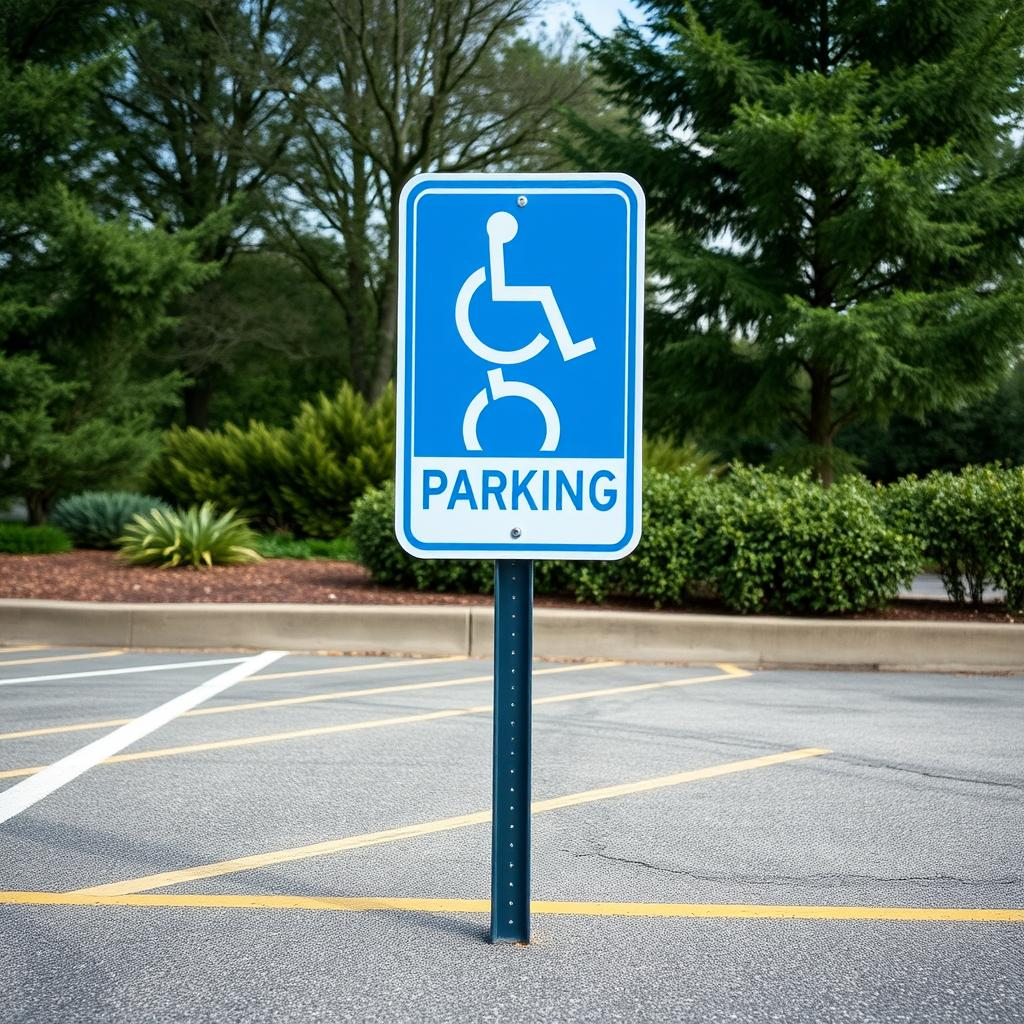A Guide to Implementing an Employee Handicap Parking
Policy

As a new supervisor, manager, or business owner, one of your earliest and most critical responsibilities is managing daily operations while ensuring strict legal compliance and fostering an equitable workplace. A particularly sensitive area requiring adherence to federal and state accessibility laws is parking, which leads us to the crucial importance of a clear and fair employee handicap parking policy. Establishing well-documented policies regarding accessible parking is not merely a formality; it is a foundational legal necessity that supports employees with disabilities while protecting your organization from potential legal exposure.
This guide will walk you through the necessity of robust policy manuals and provide two distinct, actionable examples to help you create an effective policy tailored to your company's size and needs.
Why Do I Need a Company Policy and Procedures Manual?

Before delving into the specifics of parking, you must understand the overarching value of a Company Policy and Procedures Manual (CPPM).
A Company Policy and Procedures Manual serves as the authoritative blueprint for how your company operates. For new managers, it provides instant clarity and consistency, ensuring that disciplinary actions, leave requests, and operational processes are handled uniformly across all departments and supervisors.
1. Legal Compliance and Risk Mitigation
The primary function of a Company Policy and Procedures Manual is to ensure compliance with federal regulations, most notably the Americans with Disabilities Act (ADA). The ADA requires employers to provide "reasonable accommodations" to qualified employees with disabilities. When it comes to parking, this means ensuring that accessible spaces are available, properly marked, and strictly reserved for those authorized to use them. Without a formal, written policy, your company is vulnerable to claims of arbitrary enforcement or failure to accommodate, which can result in costly lawsuits and regulatory fines. A documented policy proves due diligence.
2. Consistency and Fairness
If Supervisor A handles accessible parking permits differently than Supervisor B, it creates immediate conflict, confusion, and the perception of inequity among your staff. A Company Policy and Procedures Manual standardizes the application process, documentation requirements, and enforcement actions. This consistency fosters trust among your employees and ensures that everyone understands the rules, setting clear expectations for conduct and compliance regarding the employee handicap parking policy.
3. Managerial Training and Continuity
For you, as a new manager, the Company Policy and Procedures Manual is an indispensable training tool. It acts as an instant reference point, explaining complex HR and accessibility requirements without constant consultation with leadership or legal counsel. Furthermore, when management transitions occur, the manual ensures operational continuity, protecting the integrity of sensitive programs like the employee handicap parking policy.
Developing Your Employee Handicap Parking Policy
Framework

When drafting your specific employee handicap parking policy, you must consider four key elements: documentation, space allocation, verification, and enforcement. This policy must mesh seamlessly with your overall Reasonable Accommodation procedures outlined elsewhere in your Company Policy and Procedures Manual.
Remember, the goal is not just to comply with the letter of the law regarding the number of spaces, but to ensure that the process for accessing those spaces is fair, confidential, and consistently managed. A poorly defined employee handicap parking policy can be as detrimental as having no policy at all, as it opens the door to inconsistent application.
1st Employee Handicap Parking Policy Example: The
Comprehensive Model

This model is ideal for medium-to-large companies (100+ employees) or organizations with complex facilities, multiple buildings, and high parking demand. It emphasizes formal application and HR documentation.
Policy Title: Accessible Employee Parking Permit Program (AEPPP)
I. Purpose and Scope This policy establishes the procedures by which eligible employees may apply for and utilize designated accessible parking spaces on company property, ensuring compliance with the ADA and state regulations. This employee handicap parking policy applies to all employees and contractors utilizing company parking facilities.
II. Eligibility Requirements To be eligible for a company-issued AEPPP permit, an employee must meet one of the following criteria:
Possess a valid, state-issued disabled license plate or placard (permanent or temporary).
Have a documented disability that substantially limits mobility and requires a reasonable accommodation in the form of proximate parking, verified by the HR Department.
III. Application and Verification Procedure
Application Submission: Employees must submit a formal AEPPP Application Form to the Human Resources (HR) Department.
Required Documentation: The application must be accompanied by a copy of the employee’s valid state-issued placard (or license plate registration) and a current photo ID. If the need for proximate parking is being requested as a specific reasonable accommodation that does not require a state placard (e.g., temporary medical need immediately following surgery), the employee must complete the standard HR Accommodation Request Form, including relevant medical documentation (subject to HIPAA privacy standards).
Issuance: Upon verification, HR will issue a non-transferable Company Accessible Parking Permit (CAPP). This CAPP must be displayed alongside the state or medical documentation whenever the employee is utilizing a designated accessible space.
IV. Space Allocation and Assignment Accessible spaces are strictly reserved. Parking lot security or designated facility staff will manage assignments, prioritizing proximity based on verified medical need and facility layout. Temporary assignments will be reviewed every 30 days.
V. Enforcement and Consequences Unauthorized use of an accessible parking space—including failure to display the CAPP and state placard—will result in immediate consequences, including but not limited to:
1st Offense: Written Warning and immediate vehicle removal (at owner’s expense).
2nd Offense: Final Written Warning and suspension of all company parking privileges for 30 days.
3rd Offense: Further disciplinary action, up to and including termination of employment.
This rigorous employee handicap parking policy model ensures that HR maintains centralized control over sensitive medical information while enforcing strict compliance rules via facility management.
2nd Employee Handicap Parking Policy Example: The Small
Business/Flexible Model

This model is suitable for smaller organizations (fewer than 50 employees) or those operating in leased spaces with fewer dedicated accessible spots. It prioritizes direct communication and accommodation over complex administrative layers.
Policy Title: Accessible Parking Accommodation Protocol (APAP)
I. Purpose and Commitment [Company Name] is committed to providing reasonable accommodations, including accessible parking, for all employees with qualifying disabilities under the ADA. This employee handicap parking policy streamlines the process for smaller teams.
II. Requesting Accessible Parking Employees requiring access to designated parking spaces should notify their direct supervisor and the designated ADA Coordinator (often the owner or a single HR representative). This notification should be made as soon as the need arises.
III. Verification and Implementation
Verification: The employee must present valid evidence of their need, typically a current state-issued disabled parking placard or license plate. For non-state-placard needs (e.g., temporary accommodation), the manager will initiate a direct interactive process with the employee to determine the necessary reasonable accommodation. The use of a designated space is considered confidential medical information.
Allocation: The supervisor/ADA Coordinator will confirm the location of the best available accessible space (or an equivalent proximate space if designated spots are full or unavailable) and communicate the assignment to the employee and necessary operations staff. Depending on the parking lot, the company may designate a temporarily reserved space for the employee while the need exists.
IV. Confidentiality and Review All documentation related to an employee's need for accessible parking will be kept strictly confidential and separate from the employee’s general personnel file, stored only in the secure medical file maintained by the ADA Coordinator/HR. Temporary assignments will be reviewed annually or when the employee’s medical status changes.
V. Misuse of Parking Spaces Any employee, including management, found utilizing spaces designated for disabled access without proper authorization (either a state placard or a company-issued temporary permit) will immediately face disciplinary action. Given the small nature of the organization, misuse is considered a serious breach of company trust and a violation of this employee handicap parking policy.
This flexible employee handicap parking policy allows for a quicker, more personal response to accommodation needs while still adhering to the core ADA principle of providing necessary access.
Enforcement and Documentation

Regardless of whether you choose the comprehensive or flexible model, consistent enforcement is the backbone of any effective employee handicap parking policy. If employees perceive that the policy is inconsistently applied or that unauthorized vehicles routinely occupy accessible spaces, the entire program loses its credibility and utility.
You must partner closely with facilities or security teams to monitor these spaces daily. Any violation must trigger the documented disciplinary procedure immediately. Furthermore, periodically reviewing your overall employee handicap parking policy (at least annually) ensures that it reflects current legal standards, changes in your facilities, and any shifts in the employee population's needs.
Conclusion

Creating a detailed employee handicap parking policy is more than just complying with mandated space ratios; it is a fundamental act of ensuring dignity and accessibility for your workforce. By implementing a robust Company Policy and Procedures Manual, you provide yourself, your management team, and your employees with the clear guidance necessary to navigate these sensitive issues professionally and legally. Invest the time now to establish clear rules, consistent documentation, and fair enforcement, securing a compliant and equitable workplace for everyone.